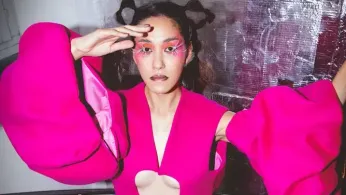
6 hours ago
Paradise in Pink: How Jacqueline Loekito’s Gender-Free Vision Is Shaping Queer Fashion Now
READ TIME: 3 MIN.
The landscape of queer fashion is in constant flux, shaped by the creative visionaries who refuse to be boxed in by tradition or binary ideas of gender. Among this new vanguard, Jacqueline Loekito has emerged as a singular force, using the color pink and playful, oversized silhouettes to articulate a vision of clothing that is radically inclusive and defiantly joyful. Loekito’s work, rooted in the ethos that “clothing has no gender," is not only turning heads on runways but is also fostering a sense of belonging for LGBTQ+ people seeking authentic self-expression in a world still governed by restrictive norms .
Founded in 2018 and based in Basel, Switzerland, the Jacqueline Loekito label was born from its creator’s desire to “share clothing from one wardrobe between men and women,” using pink—a color historically coded as feminine—to challenge and ultimately dissolve those codes . Loekito’s collections are distinguished by their candy-colored palette, generous use of soft and tactile fabrics, and silhouettes that defy conventional tailoring. The designer’s website and lookbooks are awash in pink, signaling a playful refusal to respect boundaries that have long limited queer self-presentation in fashion.
What makes Loekito’s work so impactful is her holistic approach to inclusivity. Pink is not just a color—it’s a statement, a reclamation, and an invitation. By centering pink in all her collections, Loekito subverts its gendered associations and re-presents it as a hue for everyone, regardless of identity or presentation .
Equally important is her casting. Loekito’s runway and campaign models are drawn from across the LGBTQ+ spectrum, including transgender people, nonbinary individuals, and those whose style resists categorization. This commitment to representation extends beyond tokenism, as Loekito insists on showcasing real diversity—body types, ages, and expressions—fostering visibility and solidarity .
Loekito’s collections are designed to be shared, borrowed, and adapted. This principle is realized through oversized shirts, wide-legged trousers, and dramatic coats—garments that, by their very construction, resist gendered sizing and fit. Her shows and lookbooks feature all genders in the same garments, demonstrating both the practicality and the aesthetic pleasure of a truly genderless wardrobe. As Loekito herself has noted, “clothing should be fun, and everyone should have access to that joy without fear of judgment” .
This approach is mirrored by other queer-led brands pushing gender inclusivity, such as Riley Studio, which also presents gender-fluid basics modeled by people of all genders, and Palomo Spain, whose “fusion of men’s tailoring techniques and feminine lines” similarly destabilizes the binary . However, Loekito’s relentless focus on pink and sense of unbridled playfulness set her apart.
Fashion is more than fabric—it’s ritual, community, and resistance. In queer life, dressing up and being seen are acts of affirmation and survival. Loekito’s garments, with their bold colors and joyful shapes, have become part of the visual language of queer celebration, worn at Pride events, community gatherings, and even in everyday life as quiet acts of protest against invisibility and erasure .
This year, as anti-LGBTQ+ legislation has surged globally, queer fashion has taken on added urgency. Visibility—on the runway, in advertising, and on social media—serves not only to affirm those within the community but also to challenge mainstream audiences to reconsider deeply held assumptions about gender and beauty . Loekito’s collections invite all who see them to imagine a world where self-presentation is limited only by imagination.
Loekito’s work has been recognized by both fashion media and industry insiders for its innovation and inclusivity. Her shows are covered by LGBTQ+ and mainstream outlets alike, and her distinctive pink palette has become a signature instantly recognizable to those following contemporary fashion . Beyond personal accolades, Loekito’s influence can be seen in the growing number of brands and designers embracing gender-free collections, using diverse casting, and rethinking the visual codes of masculinity and femininity.
In 2025, Loekito’s work continues to inspire a new generation of designers and fashion enthusiasts who see clothing as a tool for liberation. Her playful, pink-hued approach is echoed by a rising cohort of queer designers: Palomo Spain, Telfar, Kingsley Gbadegesin’s K.ngsly, and many more, each contributing to the tapestry of queer style with their own distinct voices .
As the boundaries between masculine and feminine, “men’s” and “women’s,” continue to erode, designers like Loekito are at the forefront of a movement that sees fashion not just as clothing, but as a form of activism. The increasing visibility of gender-expansive designers, models, and brands is changing what is possible—and acceptable—both on and off the runway .
Loekito’s pink revolution is not just a trend; it’s part of a broader cultural shift toward radical inclusivity, creative freedom, and community empowerment. In amplifying queer voices and breaking down the last vestiges of the binary, Loekito and her peers are dressing us all for a more colorful, liberated, and joyful future.






